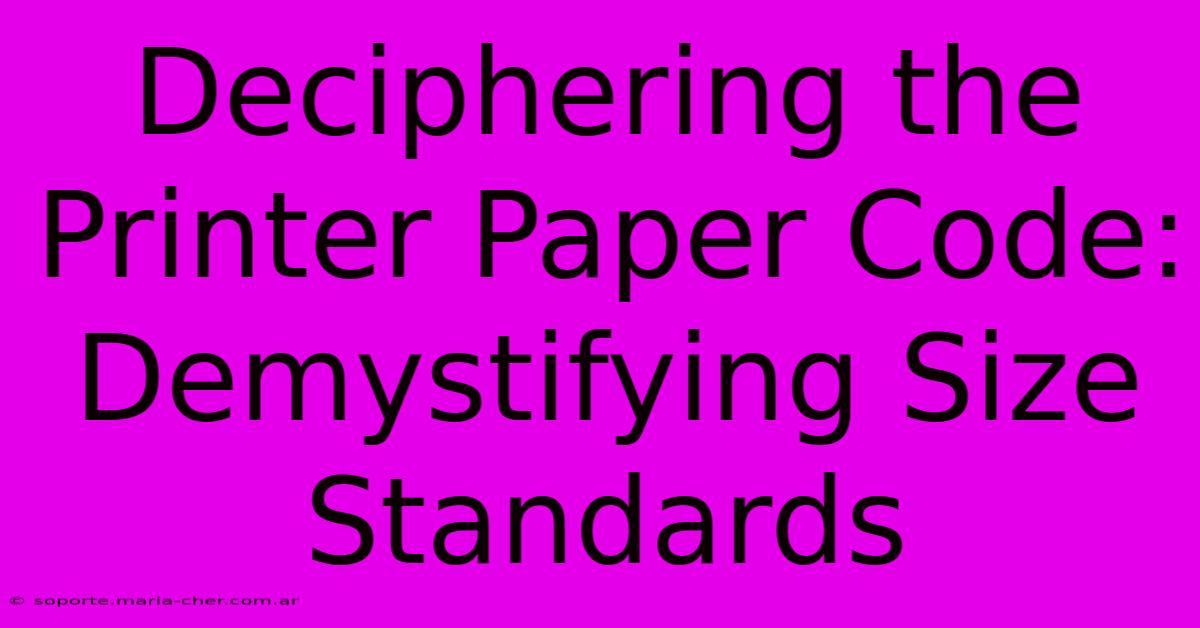Deciphering The Printer Paper Code: Demystifying Size Standards

Table of Contents
Deciphering the Printer Paper Code: Demystifying Size Standards
Choosing the right printer paper can feel like navigating a maze of cryptic codes and confusing sizes. But understanding the standard paper sizes is key to ensuring your documents print correctly and look professional. This comprehensive guide will demystify the common paper size codes, helping you select the perfect paper for any project.
Understanding Paper Size Codes: A Global Perspective
Paper sizes aren't universal. Different regions utilize different standards. The two most prevalent systems are:
1. North American Standard (Inches):
This system, primarily used in the United States and Canada, uses inches as its unit of measurement. Common sizes include:
- Letter (8.5 x 11 inches): This is the ubiquitous standard for everyday documents, letters, and reports. It's the workhorse of the paper world.
- Legal (8.5 x 14 inches): Slightly longer than Letter, Legal size is often used for legal documents, forms, and longer reports.
- Executive (7.25 x 10.5 inches): A smaller option, often used for smaller reports or stationery.
- Statement (5.5 x 8.5 inches): Commonly used for bank statements and other short communications.
2. International Standard (ISO 216):
This system, prevalent in most of the world, utilizes a metric system based on the A series. The key to this system is that each subsequent size is derived by halving the previous size.
- A0 (841 x 1189 mm): The largest size in the A series. While less commonly used for printing, it's the basis for the rest of the sizes.
- A1 (594 x 841 mm): Often used for posters and blueprints.
- A2 (420 x 594 mm): A common size for posters or larger artwork.
- A3 (297 x 420 mm): Used for brochures, larger reports, and technical drawings.
- A4 (210 x 297 mm): This is the international equivalent of Letter size, used extensively worldwide for everyday documents.
- A5 (148 x 210 mm): A half-A4 size, often used for brochures, flyers, or smaller documents.
- A6 (105 x 148 mm): Often used for postcards, business cards or smaller notes.
Beyond the Basics: Understanding Paper Weight and Other Specifications
While size is crucial, other factors influence paper selection:
Paper Weight:
Measured in pounds (lbs) or grams per square meter (gsm), paper weight affects its thickness and feel. Heavier paper (e.g., 24 lb or higher) is sturdier and more durable, while lighter paper is suitable for everyday printing.
Paper Type:
Various paper types cater to different needs:
- Bond Paper: A smooth, versatile paper suitable for various printing methods.
- Cardstock: A thicker, heavier paper ideal for business cards, postcards, and other high-quality prints.
- Photo Paper: Designed for high-quality photo printing with specific coatings.
Choosing the Right Paper for Your Project:
The best paper size and type depend entirely on your project requirements. Consider these factors:
- Document Length: Longer documents require larger sizes like Legal or A3.
- Intended Use: Business cards need cardstock, while letters require bond paper.
- Printing Method: Ensure your chosen paper is compatible with your printer.
SEO Optimization for this Article:
This article is optimized for search engines by including relevant keywords such as: "printer paper sizes," "paper size codes," "A4 paper," "Letter size paper," "paper weight," "gsm," "lbs," "bond paper," "cardstock," "photo paper," "legal size paper," "ISO 216," "North American Standard." The use of headings and subheadings improves readability and organization, which are also vital for SEO. Internal and external links (if included) would further enhance the SEO value.
By understanding these size standards and other key specifications, you can confidently select the appropriate printer paper for all your printing needs, ensuring professional and visually appealing results every time.

Thank you for visiting our website wich cover about Deciphering The Printer Paper Code: Demystifying Size Standards. We hope the information provided has been useful to you. Feel free to contact us if you have any questions or need further assistance. See you next time and dont miss to bookmark.
Featured Posts
-
Elevate Your Gaming Experience Pro Grade Micro Sd Card For Seamless Gameplay
Feb 11, 2025
-
Unleash The Speed The Ultimate Pro Grade Micro Sd Card For Lightning Fast Performance
Feb 11, 2025
-
Discover Your Dream Home Oasis Exclusive Peek Into Perry Homes Frisco
Feb 11, 2025
-
Unveiling The Luxurious Prairie Oaks 60 Perry Homes Masterpiece
Feb 11, 2025
-
Master The Art Of Expertise How To Build Credibility And Assert Your Authority
Feb 11, 2025
